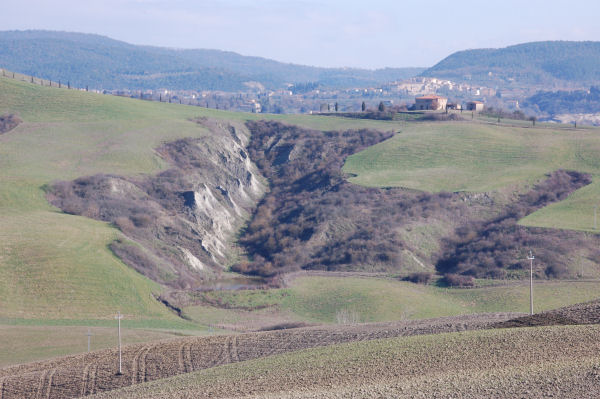The great variety of landscapes in Tuscany is confirmed by the Crete Senesi, an area that seems to belong to another planet, where the main colors are very different from those to which the traveler is used to see in Tuscany.
After exploring the medieval hamlets, walking through the parks and visiting the most peculiar places of Sienese countryside, we recommend a tour through the Crete Senesi, to see up close the calanchi and biancane.
Calanchi and biancane, typical badland landforms of Crete Senesi

Photo Biancane Credits: http://www.moveaboutitaly.com/crete/biancane_it.html
First of all, you must know that calanchi and biancane are the typical badland landforms of Crete, the south-eastern area in province of Siena whose name is derived from clay, which gives the landscape a lunar aspect, a kind of desert that features a unique charm.
Here the horizon seems to stretch into infinity, while the colors change from gray to reddish, typical of color shade called “terra di Siena”: this territory is the result of the sedimentation of the remains of the sea that completely covered this area in Pliocene era (from 2.5 million to 4.5 million years ago).
The clay soil has led to this morphology of the land, distinguished between calanchi (a sort of “scarring” of the land) and biancane (similar to dunes, towering up to 15 meters).

Photo Biancane Credits: http://www.acpb.net/crete/biancane_it.html
You can get to the Crete by car, following the A1 motorway (for those coming from the north or south), exit at Val di Chiana and take the freeway Bettolle-Siena.
After passing the exit to Rigomagno and Lucignano, the following exits lead to the Crete Senesi.
We advise you to follow the path of Taverne d’Arbia, which provides access to the Lauretana Antica road and offers a broad overview of Crete, along a road of 17 km dotted with cypress trees, farmhouses and hills up to Asciano, one of the most characteristic hamlets of this area.
The Crete Senesi are also visible from the train: you can travel along the route that leads from Siena to Buonconvento, which is part of the Crete along with Monteroni d’Arbia, Rapolano Terme and San Giovanni d’Asso, despite each one having different architectural and historical features.
About local speciies, we refer to the post Genuine flavors of Crete Senesi in spring, focused on food delights that you can enjoy in this part of the Siena province.

Credits: www.fototoscana.it/gallerie/chiusure18.jpg
Artistic itinerary in Crete: the Site Transitoire

Credits: www.acpb.net/crete/site_transitoire_it.html
We bet that here you will never expect to find a contemporary work of art, but Siena will surprise you once again with Site Transitoire, a site specific art installation, created by the artist Jean Paul Philippe in 1993.
The Site Transitoire consists of stone sculptures representing a chair, a window and a bench of an imaginary house, located on a hill between Siena and Asciano, near Leonina and Mucigliani.

Credits Sito Transitorio: Gianluca Boni https://flic.kr/p/hmjH1B
This work expresses its maximum charm at sunset, welcoming the visitor into a space that seems suspended in time.
If you wish for a memorable experience in touch with nature and want to see unusual panoramic views, Crete Senesi are an unmissable destination that will make it even more enjoyable your stay.

Credits site transitoire: Marco Micheli https://flic.kr/p/G4UZhp
Preview photo Credits: Antonio Cinotti https://flic.kr/p/omN226






0Comments